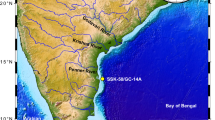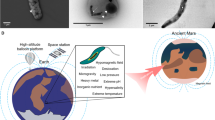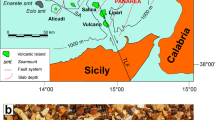Abstract
Magnetotactic bacteria produce chains of magnetite1,2 and/or greigite3,4,5 crystals within their cell bodies called magnetosomes that are permanently magnetized6. They use these magnets to navigate along geomagnetic field lines to reach their preferred habitat7. Greigite magnetosomes have been well documented in modern sedimentary environments, but their identification in the fossil record remains controversial. Here we use transmission electron microscopy, electron diffraction patterns and rockmagnetic analyses to assess the origins of nanometre-scale greigite crystals found in Pliocene claystones from the Carpathian foredeep of Romania. We find that, like modern magnetosomal greigite grains, the crystals are single domain8, with few crystallographic defects and an overall shape consistent with an intracellular origin. We suggest these crystals are magnetosomal in origin, which would place them among the oldest greigite magnetofossils identified so far. The crystals also carry a primary magnetic signal, which has remained stable since its acquisition 5.3–2.6 million years ago. We suggest that greigite magnetofossils could therefore provide reliable records of ancient geomagnetic field variations, and that they could also be used as a proxy to assess palaeoenvironmental conditions in low-oxygen sedimentary environments.
This is a preview of subscription content, access via your institution
Access options
Subscribe to this journal
Receive 12 print issues and online access
$259.00 per year
only $21.58 per issue
Buy this article
- Purchase on Springer Link
- Instant access to full article PDF
Prices may be subject to local taxes which are calculated during checkout



Similar content being viewed by others
References
Blakemore, R. P. Magnetotactic bacteria. Science 190, 377–379 (1975).
Frankel, R. B., Blakemore, R. P. & Wolfe, R. S. Magnetite in freshwater magnetotactic bacteria. Science 203, 1355–1356 (1979).
Farina, M., Esquivel, D. M. S. & Lins de Barros, H. G. P. Magnetic iron-sulphur crystals from a magnetotactic microorganism. Nature 343, 256–258 (1990).
Mann, S., Sparks, N. H. C., Frankel, R. B., Bazylinski, D. A. & Jannasch, H. W. Biomineralization of ferrimagnetic greigite (Fe3S4) and iron pyrite (FeS2) in a magnetotactic bacterium. Nature 343, 258–261 (1990).
Bazylinski, D. A., Heywood, B. R., Mann, S. & Frankel, R. B. Fe3O4 and Fe3S4 in a bacterium. Nature 366, 218–218 (1993).
Johnsen, S. & Lohmann, K. J. The physics and neurobiology of magnetoreception. Nature Rev. 6, 703–712 (2005).
Bazylinski, D. A. & Frankel, R. B. Magnetosome formation in prokaryotes. Nature Rev. 2, 217–230 (2004).
Diaz Ricci, J. C. & Kirschvink, J. L. Magnetic domain state and coercivity predictions for biogenic greigite (Fe3S4): A comparison of theory with magnetosome observations. Geophys. J. Res. 97, 17309–17315 (1992).
Hounslow, M. W. & Maher, B. A. Quantitative extraction and analysis of the carriers of magnetization in sediments. Geophys. J. Int. 124, 56–74 (1996).
Chang, S.-B. R. & Kirschvink, J. L. Magnetofossils, the magnetization of the sediments, and the evolution of magnetite biomineralization. Annu. Rev. Earth Planet. Sci. 17, 169–195 (1989).
Moskowitz, B. M. Biomineralization of magnetic minerals. Rev. Geophys. 33, 123–128 (1995).
Posfai, M. et al. Crystal-size distributions and possible biogenic origin of Fe sulfides. Eur. J. Mineral. 13, 691–703 (2001).
Skinner, B. J., Erd, R. C. & Grimaldi, F. S. Greigite, the thio-spinel of iron; a new mineral. Am. Mineral. 49, 543–555 (1964).
Reynolds, R. L. et al. Magnetization and geochemistry of greigite bearing Cretaceous strata, North Slope Basin, Alaska. Am. J. Sci. 294, 485–528 (1994).
Roberts, A. P. & Weaver, R. Multiple mechanisms of remagnetization involving sedimentary greigite (Fe3S4). Earth Planet. Sci. Lett. 231, 263–277 (2005).
Berner, R. A. Thermodynamic stability of sedimentary iron sulfides. Am. J. Sci. 265, 773–785 (1967).
Rickard, D. & Luther, G. W. Chemistry of iron sulfides. Chem. Rev. 107, 514–562 (2007).
Vasiliev, I. et al. Towards an astrochronological framework for the eastern Paratethys Mio-Pliocene sedimentary sequences of the Focsani basin (Romania). Earth Planet. Sci. Lett. 227, 231–247 (2004).
Vasiliev, I., Krijgsman, W., Stoica, M. & Langereis, C. G. Mio-Pliocene magnetostratigraphy in the southern Carpathian foredeep and Mediterranean-Paratethys correlation. Terra Nova 17, 374–387 (2005).
Vasiliev, I. et al. Early diagenetic greigite as a recorder of the palaeomagnetic signal in Miocene–Pliocene sedimentary rocks of the Carpathian foredeep (Romania). Geophys. J. Int. 171, 613–629 (2007).
Panaiotu, C. E., Vasiliev, I., Panaiotu, C. G., Krijgsman, W. & Langereis, C. G. Provenance analysis as a key to orogenic exhumation: A case study from the East Carpathians (Romania). Terra Nova 19, 120–126 (2007).
Stoica, M., Lazar, I., Vasiliev, I. & Krijgsman, W. Mollusc assemblages of the Pontian and Dacian deposits in the Topolog-Arges area (southern Carpathian foredeep - Romania). Geobios 40, 391–405 (2007).
Kopp, R. E. & Kirschvink, J. L. The identification and biogeochemical interpretation of fossil magnetotactic bacteria. Earth Sci. Rev. 86, 42–61 (2007).
Kobayashi, A. et al. Experimental observation of magnetosome chain collapse in magnetotactic bacteria: Sedimentological, paleomagnetic, and evolutionary implications. Earth Planet. Sci. Lett. 245, 538–550 (2006).
Kruiver, P. P., Dekkers, M. J. & Heslop, D. Quantification of the magnetic coercivity components by the analysis of acquisition curves of isothermal remanent magnetisation. Earth Planet. Sci. Lett. 189, 269–276 (2001).
Rowan, C. J. & Roberts, A. P. Magnetite dissolution, diachronous greigite formation, and secondary magnetizations from pyrite oxidation: Unravelling complex magnetizations in Neogene marine sediments from New Zealand. Earth Planet. Sci. Lett. 241, 119–137 (2006).
Pike, C. R., Roberts, A. P. & Verosub, K. L. Characterising interactions in fine magnetic particle system using first order reversal curves. J. Appl. Phys. 85, 6660–6667 (1999).
Simmons, S. L., Sievert, S. M., Frankel, R. B., Bazylinski, D. A. & Edwards, K. J. Spatiotemporal distribution of marine magnetotactic bacteria in a seasonally stratified coastal salt pond. Appl. Env. Microbiol. 70, 6230–6239 (2004).
Tauxe, L. Inclination flattening and the geocentric axial dipole hypothesis. Earth Planet. Sci. Lett. 233, 247–261 (2005).
Acknowledgements
This work was financially supported by the Netherlands Research Centre for Integrated Solid Earth Sciences (ISES) and the Netherlands Geosciences Foundation (ALW) with support from the Netherlands Organization for Scientific Research (NWO). J. Kirschvink is thanked for providing the new code for the single-domain stability field of greigite.
Author information
Authors and Affiliations
Contributions
I.V. initiated the project, undertook the analyses and provided the interpretation. C.F. and J.D.M. assisted and advised on TEM microscopy. C.G.L. assisted with the NRM analyses and the TK03.GAD correction. M.J.D. and W.K. advised and assisted throughout.
Corresponding author
Supplementary information
Supplementary Information
Supplementary Information (PDF 4343 kb)
Rights and permissions
About this article
Cite this article
Vasiliev, I., Franke, C., Meeldijk, J. et al. Putative greigite magnetofossils from the Pliocene epoch. Nature Geosci 1, 782–786 (2008). https://doi.org/10.1038/ngeo335
Received:
Accepted:
Published:
Issue Date:
DOI: https://doi.org/10.1038/ngeo335
This article is cited by
-
Discovery of late Quaternary giant magnetofossils in the Bay of Bengal
Communications Earth & Environment (2024)
-
Magnetotactic bacteria and magnetofossils: ecology, evolution and environmental implications
npj Biofilms and Microbiomes (2022)
-
Nanoscale transformations of amphiboles within human alveolar epithelial cells
Scientific Reports (2022)
-
Controls on greigite preservation in a gas hydrate system of the Krishna-Godavari basin, Bay of Bengal
Geo-Marine Letters (2020)
-
Magnetic properties of uncultivated magnetotactic bacteria and their contribution to a stratified estuary iron cycle
Nature Communications (2014)



